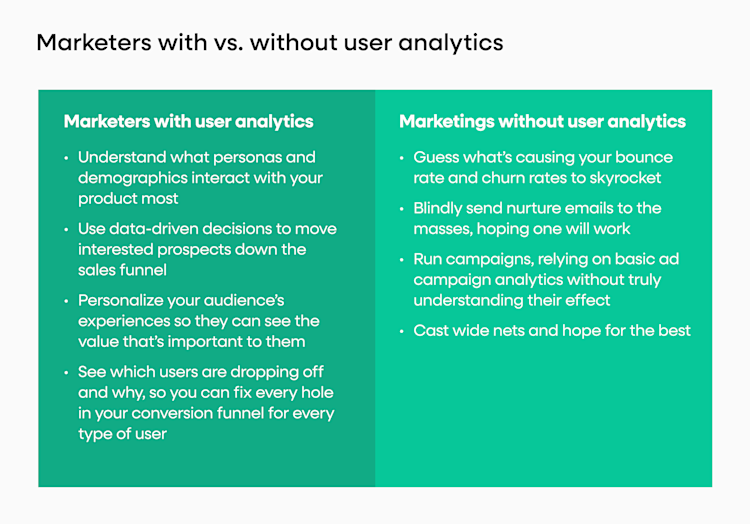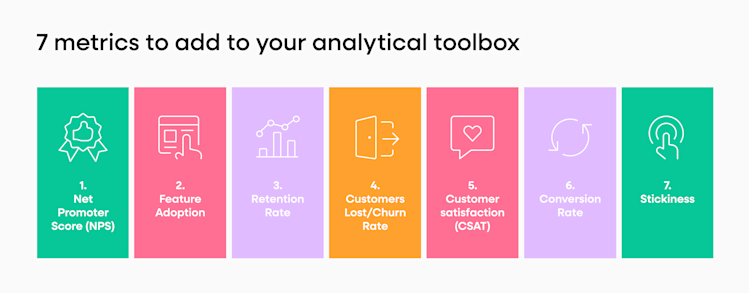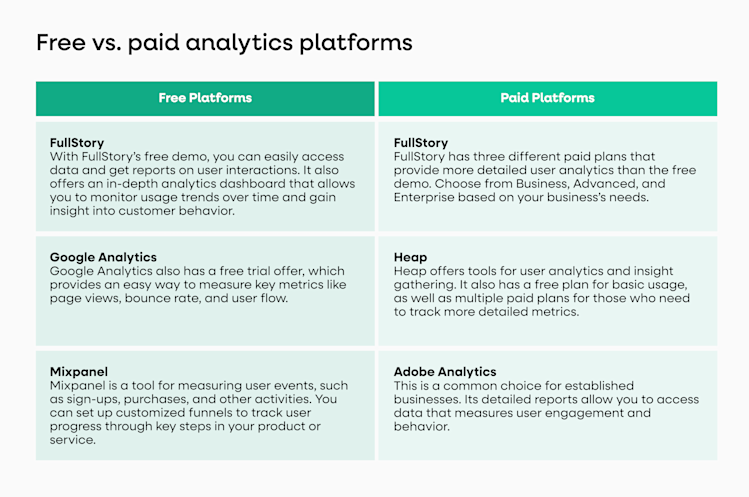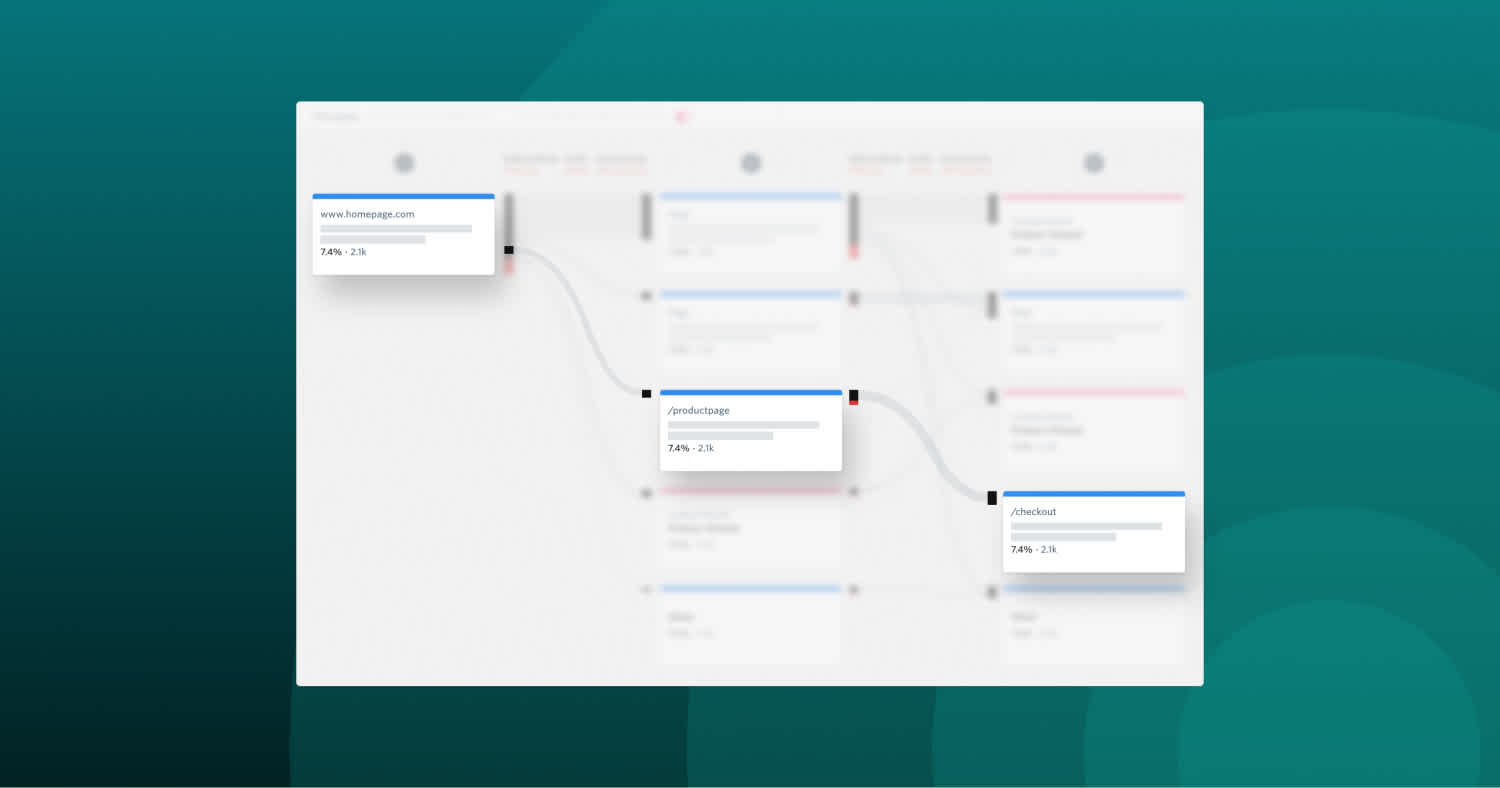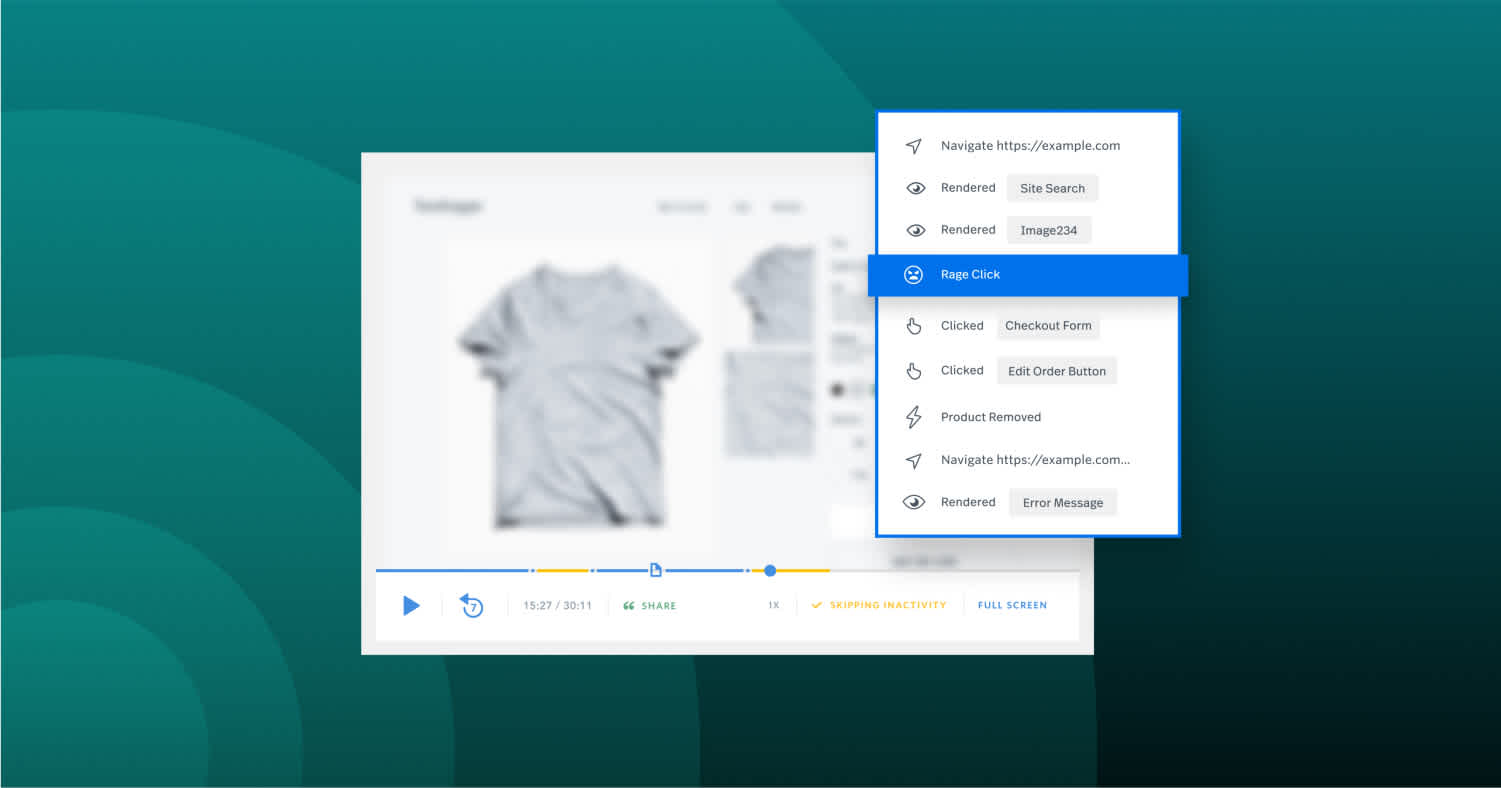Anyone who builds, sells, or supports digital experiences needs to make sure they’re providing customers with the best user experience possible.
That’s why user analytics is essential for understanding their behavior and getting a better sense of what they are looking for.
This guide will provide an overview of user analytics, its importance, and how it can be used to improve the user experience so that you can optimize your website or app for success.
Key takeaways
User analytics is the process of gathering, analyzing, and interpreting qualitative and quantitative data about website or app user behavior.
It provides valuable insights into how users interact with your website or app, helping you make informed decisions to improve user experience and optimize for success.
User analytics can be used to identify areas of improvement, as well as discover what’s working well in terms of user engagement.
There are various tools and techniques available to track and analyze user data.
What is user analytics?
User analytics is a type of data analysis that focuses on understanding user behavior, preferences, and interests. It involves analyzing user data like demographics, interactions with products or services, engagement metrics (e.g. clicks), and more in order to gain insights into how people interact with digital experiences.
What’s more, user analytics provides valuable insight for product teams, product owners, marketers, and other digital professionals who need to understand how their users interact with their products or services.
There are three primary categories of user analytics:
Segment Analytics
Segment analytics helps product owners and marketers to understand how users are grouped together and why they behave differently. It uses different metrics like demographic information, interests, and engagement metrics to create segmented user profiles, which can be used for targeted campaigns or personalized experiences.
Dive into Fullstory
With Fullstory, you can slice and dice comprehensive user data to better understand and empathize with every important segment.
Funnel Analytics
Funnel analytics focuses on understanding how users move through the customer journey, from awareness to purchase. It helps marketers and product owners understand what is working and where improvements can be made.
Cohort Analytics
Cohort analytics is a type of analysis that examines how user behaviors change over time. It allows product owners and marketers to see how users who share similar characteristics are behaving differently and to make adjustments as needed.
User analytics can be used to inform product or service design, marketing strategies, UX decisions, UI design, and more. It is an invaluable tool for understanding how users interact with digital experiences and making informed product or service development decisions.
With the right user analytics in place, product owners and marketers can get the insights they need to create successful products and services.
Who uses user analytics?
User analytics is an invaluable resource for most teams across an entire company, including marketing departments, engineers, and customer experience.
Why is user analytics important for marketing?
User analytics is a vital tool for marketing teams. By understanding how users behave and what they want, marketers can create more effective campaigns and optimize their efforts to get the most out of them.
Why is user analytics important for engineering?
User analytics is also a must for engineering teams. Thanks to user analytics, engineers can better understand how users interact with the product and identify where changes are necessary to improve the user experience and avoid user friction. This could include making an interface more intuitive or adding new features that customers have requested.
Why is user analytics important for CX teams?
Finally, user analytics is invaluable for customer experience (CX) teams. It enables CX professionals to gain insights into how customers feel about their experiences with the product and identify areas where they need to make improvements to ensure optimal customer satisfaction.
Why is user analytics important for SaaS?
User analytics is an essential tool for Software as a Service (SaaS) businesses. SaaS organizations rely on user data to identify opportunities, trends, and potential issues in the customer base.
By analyzing user behavior and usage patterns, SaaS organizations gain valuable insights that inform their decision-making and product design processes.
With user analytics, SaaS organizations can more effectively target their marketing messages, increase customer retention rates, and drive revenue growth.
User analytics can help identify areas for improvement within the product or service offering. It allows SaaS companies to understand better how users interact with their applications so they can make informed decisions about how to improve them.
This includes understanding the most common customer issues and identifying potential new features that could benefit users.
User analytics can also help SaaS organizations understand where customer friction points exist and how to address them in order to improve customer satisfaction.
Additionally, user analytics can help determine which customers are at risk of churning so that SaaS organizations can take proactive steps to retain them.
By monitoring user behavior and usage patterns, SaaS organizations can identify customers who are likely to churn so they can take action to address the root causes of churn.
Overall, user analytics is an essential tool for SaaS businesses. It helps them better understand their customer base and how users interact with their products so they can make the best decisions about creating better customer experiences.
By leveraging user analytics, SaaS organizations can unlock new opportunities for growth while increasing customer satisfaction and retention rates.
The user analysis process
User analysis is a multi-step process to collect and make sense of data about user behavior and preferences.
Step 1: Starting with personas
Personas help visualize the needs, characteristics, and preferences of a target group of users. They also provide insight into how different types of users experience the product or service—a crucial factor in understanding user behavior.
Step 2: Selecting a user analytics tool
Choosing the right user analytics tool is essential to gathering the data needed for informed decision-making. Tools can range from basic web analytics platforms like Google Analytics to more complex solutions like Fullstory.
Depending on the depth of your user analysis strategy, you might want to consider user analytics tools specific to your product or industry.
It’s important to note that the more information you can provide a user analytics tool with, the better your results will be. When you have better insights into your customer base, you'll have a better chance of success over your competitors.
Step 3: User journey analysis—mapping out users
User journey analysis involves tracking users’ paths through your product or service and understanding how the user interacts with it.
The goal is to identify potential opportunities for improvement and increase user engagement, retention, and conversion rates.
For this step, funnel analytics tools can be especially useful in getting a comprehensive view of each user’s “map” and what happens before and after they land on your website or app.
Dive into Fullstory
With Fullstory’s funnels and conversions, you can validate that the paths you’ve built are working as intended or quickly spot areas where users get off track.
Step 4: Product design, creation, and implementation
Once the user analytics have been gathered, analyzed, and interpreted, it’s time to move on to creating a product or service. This step involves understanding user needs and incorporating them into the design and development of your product or service.
The development team should clearly understand the customer requirements and be aware of any technical constraints, such as time, budget, and resources. This will ensure that the product meets all the necessary requirements while still being achievable within the given parameters.
Once development is complete, it’s important to test the product by releasing it into a limited market for feedback and further analysis. This can help identify potential issues or areas for improvement and fine-tune the product before launch.
Finally, once the product or service is ready to be released into the market, it’s time to monitor its performance and user engagement.
This way, you can ensure that your product meets customer needs—that’s the power of metrics. If it doesn’t, you’ll have the data to adjust accordingly.
Step 5: Analyze and apply your findings
Now that you have collected data and created user journey maps, it is time to analyze the information. This step requires a thorough evaluation of your data, as well as making creative decisions on how best to apply the findings.
You should focus closely on areas like user engagement, product usage trends, and possible barriers or issues users may be experiencing. If a user journey map reveals any painful points in the process, you must identify and address those problems.
Determining the essential analytics you want to measure
The type of analytics you measure can depend on the specific industry or sector you are operating in, but some common metrics include page views, return visits, bounce rate, user session duration, and conversion rate. You can complement these data using tools like session replay and heatmaps.
Survey analytics
Survey analytics is a great way to gain insight into customer behavior and user experience. By asking questions related to product performance, customer service, or other topics that can help improve the user experience, you can gain valuable information about how your users interact with–and perceive–your site or app.
Product analytics
Product analytics helps you to track how customers interact with your product and measure the performance of key features. This type of analytics can help you identify areas for improvement and better understand the customer journey.
Tracking data like feature usage, user demographics, and clickstreams will give you a better understanding of what’s working and what needs improvement.
Another aspect of product analytics is frequency and recency analysis. This helps you understand the behaviors of customers who use your product frequently and those who return less often.
It’s important to be aware of how often customers are engaging with your product so that you can better connect with them and make improvements when necessary.
Web analytics
Web analytics is the analysis of quantitative data collected from your website. This form of analytics helps you understand how visitors interact with your site, what pages they view (or don’t view), and what actions they take (or do not take).
Google Analytics and Fullstory are good examples of useful analytics tools that are commonly used to measure web analytics. It allows you to track and measure website visitors, traffic sources, page views, conversions, goal completion, and more. This is all vital data when creating an effective user journey and improving the overall customer experience.
How to set up a system for measuring analytics
Creating a system for measuring analytics is not overly complicated. It involves setting up tracking tools, like Fullstory, to measure and collect data from users on your website or app. With the right data points in place, you can analyze user behavior and trends.
The first step when setting up an analytics system is to identify which metrics and KPIs you want to measure. This could include page views, clicks, time spent on the page or app, conversions, user retention, and more.
Once you have identified which metrics to track, you can determine the teams that are using the data. Depending on the size of your organization, this may include marketing, product, customer service, and executive teams.
And once you have determined who will be using the data and what metrics they need to track, you can better determine what resources you need to measure analytics successfully.
The best platforms for measuring user analytics
When it comes to measuring user analytics, there is a plethora of tools available to you. Depending on your budget and the level of detail you need, you can choose from a variety of metrics-measuring services and software packages that can provide powerful insights into how users interact with your product or service.


